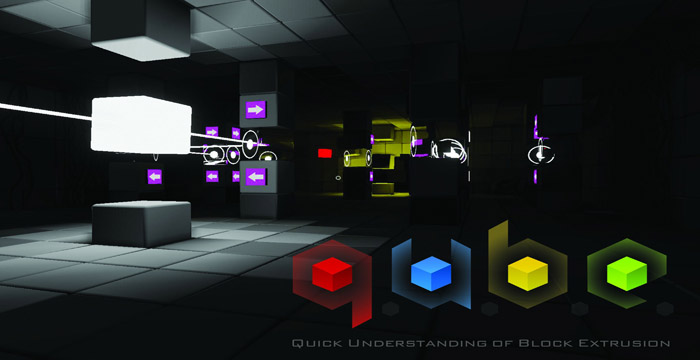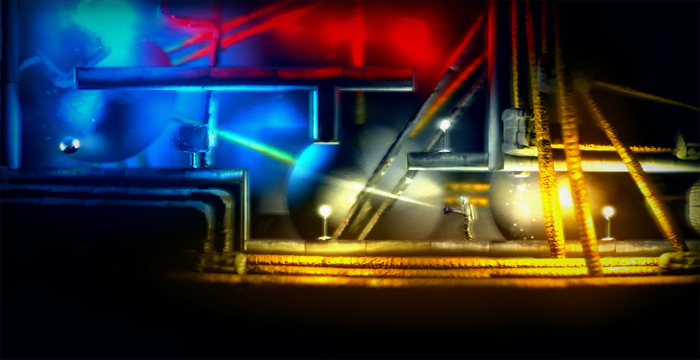Influences are a wonderful and dangerous thing. When you’re making a game, it’s great to have a touchstone you can go to when you run into crazy design problems. Games in similar genres to your own most likely faced the same design issues you may be running into, and being able to see how those games’ developers solved these issues can be a real asset. The danger is taking too much inspriration from these games. It’s not about stealing ideas, though you don’t want to do that either, it’s about not losing your game’s identity because you’re using someone else’s ideas. And this can be something that’s dangerously easy to do because, again, similar genres run into similar design challenges. So I wanted to run through some of C3‘s gaming influences to let everyone see the stuff we’re drawing inspiration from and what we’re trying to stay away from in order to form the game’s identity.
Portal and Portal 2
So let’s just get the big one out of the way first. If you’re making a 3D puzzle game, it’s hard not to be drawn to the Portal series. It’s just an elegant design and one that’s very appealing, the idea of having a single tool that’s used to interact with the world and a series of confined areas that hold the puzzles, which are composed of small elements that relate to the main mechanic. So you have small, simple game actors that can be used to create interesting gameplay on their own or in combination, but all with the portal idea. It’s a structure that’s very open, meaning puzzles can be varied in many ways, but also simple, meaning players are not overwhelmed by the amount of elements or options and can think outside of their very rigid box to come up with puzzle solutions. The two games have become the standard for 3D puzzle games in a very real way.
And we’ve followed a lot of the groundwork the Portals have laid down. We have a very small toolset the player can draw from, trying to keep things simple, and a lot of smaller elements that can create interesting gameplay on thier own but also speak to the rotation mechanic. It’s a great foundation to build from when you’re starting a 3D puzzle platformer, but we also see the danger in structuring ourselves too similarly to Portal. We’re keeping a close eye on our story, world design, and even puzzles to make sure we’re not copying anything that makes Portal what it is.
Q.U.B.E.
 This is a game we were looking from the very beginning. In fact it was referenced in the first draft of our GDD, before we even made a prototype. It was a puzzle platformer with a heavy emphasis on puzzles, and we liked the way it delivered information about its puzzles. We particularly liked the use of color, and the way the colorful gameplay elements stood out from the blank backgrounds. We weren’t looking at the cubic art style at that point, but it is something we came back to later for inspiration.
This is a game we were looking from the very beginning. In fact it was referenced in the first draft of our GDD, before we even made a prototype. It was a puzzle platformer with a heavy emphasis on puzzles, and we liked the way it delivered information about its puzzles. We particularly liked the use of color, and the way the colorful gameplay elements stood out from the blank backgrounds. We weren’t looking at the cubic art style at that point, but it is something we came back to later for inspiration.
One the biggest complaints we had with the game was its lack of an overall experience or story. While I respect the team’s decision to soley focus on the puzzle aspect of the game and let that speak for itself, and while I don’t think every game needs a narrative, the experience in Q.U.B.E. really felt lacking because of the absence of a story or characters. I think it’s important for C3‘s narrative to be one of the strong motivators for the player to keep moving forward. I think it would feel like something is missing without it.
The Swapper
This is a game I draw a lot of inspiration from for the puzzle and level design of C3. While I was playing it I couldn’t help but feel the developer had a lot of the same goals we do with the mechanics and world. I’ve really studied the puzzles, how elements are locked away at certain times to encourage the player the think outside of the box, how the story is delivered, through small snipets that lets the player put the pieces together, and the atmosphere, the use of color and effects that create the somber and desolate mood.
The swapper gun is also something that’s close to what we’re trying to accomplish with the rotation device, the idea of having two functions that provide two very different state changes in the world. It’s simplistic, so the player can easily grasp it, but there’s a lot of mileage to be gained through the use of a few additional elements.
Recently we’ve even been looking at the semi-open world structure and what benefits and negatives it has. More on that later…maybe. In any regard, The Swapper is something we’re going to continue to analyze because it’s such a well built and cohesive experience.
Braid
Similarly to the Portal series, Braid is such an important landmark in puzzle games in the last few years that it’s a big mistake not to look at it. Even though it’s 2D, I’ve learned a lot of lessons from the structure of its puzzles and environment. It taught me that a puzzle should have all its elements in front of the player at one time. Take this screenshot for example. The level will continue if you follow the path to the upper right, but everything needed to open that door and get to the puzzle piece is on the screen. The solution is obscure but none of the pieces of the puzzle are. The same can be said for the player abilities. The player knows exactly what options and tools he/she has available, so there’s never any doubt that you’re missing a tool or ability.
There’s a lot of lessons in the art as well. Look at the stark difference between the foreground and background. Through the use of color they’re easily distinguishable. And all of the game elements are obvious, and not ambiguous. All of the walking surfaces are very defined, the spikes look dangerous, and the big keyhole needs a big key. These are things that seem very obvious but can be easy to overlook. It’s easy, sort of, just to make a game look good or play well. It’s hard to find the balance between the two.
Scale
So none of us have played Scale but it’s one we’re all watching develop. It’s just so similar to C3‘s concept. Scale is a 3D puzzle platforms that about scaling stuff. C3 is a 3D puzzle platformer about rotating stuff. They’re games that have a central hook, a core mechanic that drastically changes the world around you. So because Scale is a little ahead of us in its development cycle, and because we feel the target audiences overlap a great deal, we’ve been keeping a close eye on the interest level of this game.
There are other games that we reference and draw inspiration from, and plenty of non game stuff too (for a later blog!), but these are the ones we seem to keep coming back to, both for aesthetic and mechanical reasons. They’re all great puzzle games, each with their own identity and gameplay hook, and with any luck C3 will have a place among them one day.
Thanks for reading.
Donald




